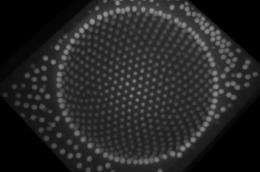Physicists grow pleats in two-dimensional curved spaces

(PhysOrg.com) -- A design feature well known in skirts and trousers has now been identified in curved, two-dimensional crystals. As University of Chicago physicist William Irvine and his colleagues report in this week’s Nature, crystalline arrays of microscopic particles grown on a negatively curved surface can develop linear defects analogous to fabric pleats. The results will facilitate a more general exploration of defects in curved spaces, including potential applications in engineered materials.
The problem of tiling a curved surface with hexagons is familiar from soccer balls and geodesic domes, in which pentagons are added to accommodate the spherical (positive) curvature. Interacting particles that form hexagonal patterns on a plane — known as ‘colloidal crystals’ — adopt these and other types of topological defects when grown on a sphere.
Irvine, an assistant professor in physics, and colleagues have developed an experimental system that allows them to investigate crystal order on surfaces with spatially varying curvature, both positive and negative. On negatively curved surfaces, they observed two types of defect that hadn’t been seen before: isolated heptagons (analogous to the pentagons on a sphere) and pleats.
The pleats allow a finer control of crystal order with curvature than is possible with isolated point defects, and may find application in curved structures such as waisted nanotubes (long, thin microscopic cylinders of material that display novel properties), or in materials created by techniques that permit control at the atomic and molecular levels, such as soft lithography or directed self-assembly.
More information: “Pleats in crystals on curved surfaces,” William T.M. Irvine, University of Chicago; Vincenzo Vitelli, Leiden University; and Paul M. Chaikin, New York University, Nature, Dec. 16, 2010, Vol. 468, No. 7326, pp. 947-951. www.nature.com/nature/
Provided by University of Chicago




















